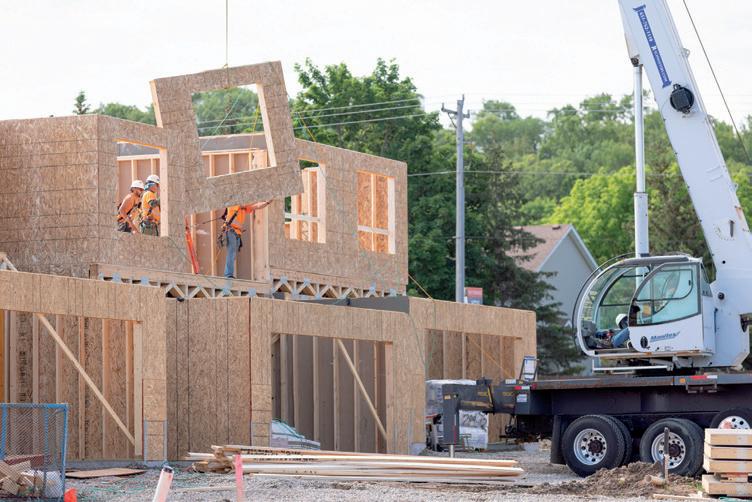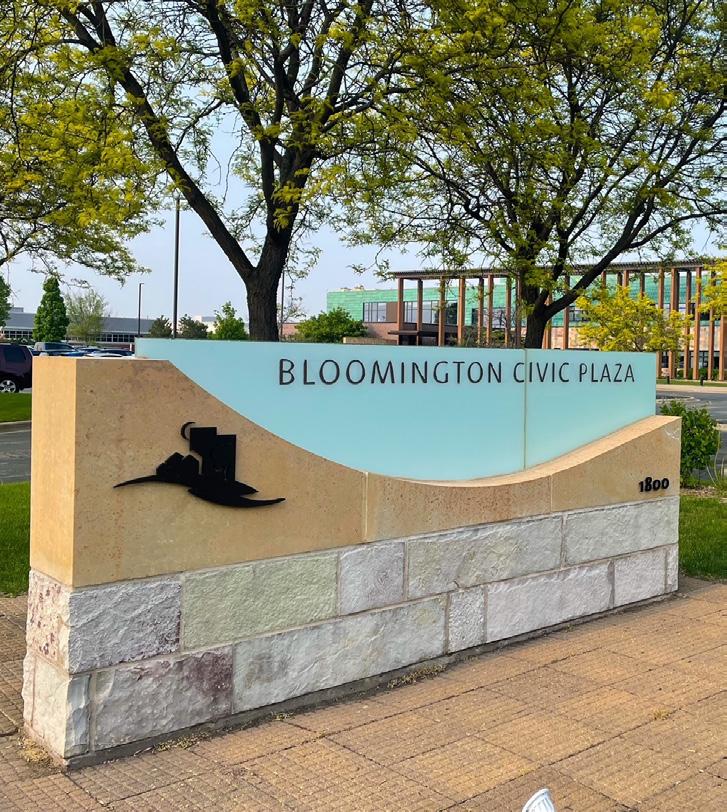Judge hears building permit profit lawsuit
The suit alleges millions of dollars were collected by municipalities by overcharging permits and inspection services.
Hennepin County Judge Francis Magill heard arguments in the lawsuits alleging the cities of Corcoran and Dayton overcharged for new residential building permits. The lawsuits were brought by Housing First Minnesota, publisher of Housing Industry News.
The April 7 hearing covered both cases and comes nearly two years after the lawsuits were filed.
Separate cases, similar arguments
While both cases were heard together, involve the same underlying case law and were raised by the same plaintiff, these are two separate court cases.
The suits against the cities of Corcoran and Dayton allege the cities inflated the cost of building permits above the cities’ costs for inspection and plan review. Minnesota uses a feefor-service model for building permits. State law requires these building permit fees to be “fair, reasonable, and proportionate to the actual cost of the service for which the fee is imposed.”
At the April 7 hearings, Magill heard arguments in both cases simultaneously.
From 2018 until 2021, Housing First Minnesota alleges the city of Corcoran collected more than $2.5 million in surplus building permit revenue, which was then placed into the city’s general funds and was used to pay for municipal development projects.
During the hearing for the city of Dayton, the discussion was similar. According to court filings, the city was accused of over-collecting $2.9 million for the years 2018-2021, with all but $200,000 diverted to the city’s 409 Fund.
“As our briefs illustrated and our attorney highlighted in today’s hearing, both the cities of Corcoran and Dayton were overcharging
CONTINUED >> PAGE 6
Legislature takes a pass on zoning reform, focuses on state funding for housing
With a housing market facing generational challenges in supply and affordability, the Minnesota Legislature chose to allocate state funds to an array of housing subsidies and support programs. All told, the Legislature and Gov. Walz signed off on a housing bill with more than $1 billion dedicated to housing programs over the next biennium. The new law also includes a metro sales tax which would increase taxes in the seven-county metro area by a quarter-cent to fund state-based vouchers and housing programs run by local governments.
Largely absent from the debate was transformational zoning modernization, which has been the centerpiece of housing legislation throughout the country for states grappling with similar housing challenges. Industry leaders lamented the narrower approach of the Legislature.
“Passing a major funding bill for housing was a significant accomplishment, but not pairing it with zoning modernization
legislation was a miss,” said James Vagle, CEO of Housing First Minnesota.
The lone zoning modernization discussion came late in the session and was limited to one legislative hearing, with the Legalize Housing Affordability Act being heard and passed out of the House of Representatives Housing Committee. Authored by Rep. Steve Elkins (DFL-Bloomington), the bill contained several key issues to limit outdated and unnecessary homeowner mandates, while returning home size and aesthetic choices to homeowners. Nearly a dozen testifiers spoke in support of large portions of the bill, while representatives of local units of government spoke in opposition.
“Minnesota suburbs, like many local governments nationwide, use zoning to curate which types of people can move to town,” said Salim Furth, a housing policy expert with the Mercatus Center at George Mason University. “This is an inappropriate use of government power and tramples on property rights and fair housing principles.”
The bill passed out of its first committee, but it was not debated after its initial hearing. The Minnesota Senate held no hearings on zoning modernization during the 2023 session.

The Legislature’s focus on housing funding yielded large investments in several programs.
Housing Bill funding highlights:
• $200 million for down payment assistance programs. This includes $150 million for first-generation down payment assistance.
• $200 million for housing infrastructure investments.
• $95 million for the Economic Development and Housing Challenge Program to support new workforce housing.
• $40 million to support workforce housing and infrastructure in Greater Minnesota.

CONTINUED >> PAGE 11
DFL passes wage liability law
Broad construction industry opposition to a liability shift for payroll and wages was brushed aside by DFL leaders as part of a sweeping collection of changes long favored by Democrats and labor unions. The statute, originally authored by Sen. Judy Seeberger (DFL-Afton) and Rep. Sandra Feist (DFL-New Brighton), provides that a contractor “has assumed a subcontractor’s liability . . . for the full payment of wages, gratuities, and overcompensation.” The language also requires subcontractors to provide payroll, wage and benefit information, if requested, to any upstream contractor.
HOUSING INDUSTRY NEWS | 1
VOL. 7 ISSUE 2, JUN. 2023 THE MINNESOTA HOUSING INDUSTRY NEWS SOURCE BY HOUSING FIRST MINNESOTA • HOUSINGINDUSTRYNEWS.ORG
INSIDE THIS ISSUE 2960 Centre Pointe Drive Roseville, MN 55113 HousingFirstMN.org PRSRT STD U.S. POSTAGE PAID PERMIT # 93652 TWIN CITIES, MN
Bloomington to enact zoning reform PAGE 4 Homebuilder sentiment rises PAGE 12 Housing First Minnesota Foundation Gala breaks records PAGE 18
CONTINUED >> PAGE 11
The housing bill signed by Gov. Walz and the Minnesota Legislature allocates more than $1 billion to housing programs over the next biennium, but fails to include transformational zoning modernization.
Great housing debate waits
The 2023 legislative session has come to its conclusion after a flurry of housing industry issues were introduced and debated.
There was no shortage of new initiatives relating to housing regulation this session. From the creation of a housing tax to fund future road improvements to a ban on the construction of single-family homes for rent and a host of environmental protection provisions relating to the energy code and electric vehicle charging –new ideas were seemingly everywhere.
None of these initiatives were passed into law, likely due to a growing awareness that the staggering regulatory costs are already disrupting our housing market, along with the fact that newly built and remodeled homes are already the most energy efficient in the country.
One change did pass into law that will impact our industry. A new requirement will place wage and payroll liability with general contractors
and their downstream subcontractors. Industry attorneys are reviewing the law to sort out its function, and Housing First Minnesota will be providing educational opportunities to ensure the industry fully understands the changes.
Perhaps the biggest legislative session story is the issue that barely got any debate at all: modernizing zoning and our housing approval process.
There isn’t anything more central to getting our housing market to a healthy place, than the great housing debate to modernize zoning. Minnesota is a curious outsider to this discussion thus far. Other states – both blue states and red states –have engaged in deep policy discussions about the future of housing choice and homeownership.
The debates are difficult, but critical to providing homeownership opportunities to tomorrow’s generation of Minnesotans. The Minnesota Legislature’s essential silence on this issue is a miss in 2023, but a silver lining emerged late in session where committee leaders shared their commitment to tackle this issue in 2024.
Looking ahead, the great housing debate
HousingIndustryNews.org
Subscribe
in 2024 will be the top industry issue. We look forward to creating the opportunity for homeownership for all Minnesotans.
Make it a great summer, John Quinlivan
Stay up to date on the latest housing news. Subscribe to our newsletter at HousingIndustryNews.org

Advertising
For advertising information, rates, editorial calendar and production specifications, contact: Brad Meewes at 651-269-2399 (Brad@HousingFirstMN.org) or Kori Meewes at 612-801-9874 (Kori@HousingFirstMN.org)
News Tips
Have an idea for a story for our next issue? Contact Editor Katie Elfstrom at Katie@HousingFirstMN.org or send your story to Info@HousingIndustryNews.com
Follow Us
HOUSING INDUSTRY NEWS
June 2023, Volume 7, Issue 2
PUBLISHER
James Vagle James@HousingFirstMN.org
EDITOR Katie Elfstrom
Katie@HousingFirstMN.org
ASSOCIATE EDITOR
Laura Burt
GRAPHIC DESIGN
Emily Doheny
ACCOUNTING
Janice Meyer
ADVERTISING SALES
Brad Meewes
Kori Meewes
CONTRIBUTING WRITERS
Katie Elfstrom Katie@HousingFirstMN.org
Nick Erickson Nick@HousingFirstMN.org
Mark Foster Mark@HousingFirstMN.org
Kristen Ober Kristen@HousingFirstMN.org
Kate Wigley Kate@HousingFirstMN.org
James Vagle James@HousingFirstMN.org
Sarah Hinderman Sarah@HousingFirstMN.org
Housing First Minnesota
James Vagle, Chief Executive Officer

John Quinlivan, Board Chair
Go to HousingIndustryNews.org for subscriber exclusives, breaking housing news and features.
Be a part of the growing housing movement in Minnesota. Twitter: Follow us @housingindsutrynews_mn Facebook: facebook.com/HousingIndustryNewsMN
Association Health Plan

Housing First Minnesota members save on average 7-10% on their annual premiums. Additionally, employers can maintain their costs year after year and offer a higher benefit than most other comparable health plans.
Wide array of quality plans offered by Blue Cross Blue Shield of Minnesota.
Attract and retain the best employees in the business while saving money.
Start saving today at HousingFirstMN.org/AssociationHealthPlan
Housing Industry News is a publication of Housing First Minnesota. Housing Industry News is published and distributed four times per year to housing industry professionals and others associated with the homebuilding industry. Neither the advertisers, nor Housing First Minnesota, will be responsible or liable for misinformation, misprints, typographical errors, etc., herein contained. For address change information, contact Housing First Minnesota. Suggestions, ideas and letters are welcome.
HOUSING INDUSTRY NEWS 2960 Centre Pointe Drive Roseville, MN 55113 info@HousingFirstMN.org housingindustrynews.org
Housing Industry News is published by Housing First Minnesota
Entire contents copyright 2023 All rights reserved
Housing First Minnesota is the voice for homebuilders, remodelers and all who are dedicated to building safe, durable homes at a price Minnesotans can afford.
Housing First Minnesota is dedicated to advancing the American dream of homeownership for Minnesotans and is the leading resource for housing-related issues in Minnesota. This advocacy work has never been more important. The housing industry remains under intense regulatory and political pressures that impact Minnesota homeowners’ ability to buy, build and remodel their dream home. Housing First Minnesota supports reasonable policies, regulations and protections, but our call for affordability for families is a voice that must be heard.
Learn more at HousingFirstMN.org.
2 | HOUSING INDUSTRY NEWS SIGN UP TO BE A PART OF THE HOUSING MOVEMENT • HOUSINGINDUSTRYNEWS.ORG
BOARD CHAIR NOTE
John Quinlivan 2023 Housing First Minnesota Board Chair
Across the country, there is much talk about housing
HERE ARE SOME OF THE LATEST QUOTES ON THE STATE OF THE INDUSTRY:
It is fundamentally a supply problem.”
NEEL KASHKARI CHAIR OF THE MINNEAPOLIS FEDERAL RESERVE
The A45 Amendment requires mandatory up-zoning in all Minnesota cities to allow duplexes in any area zoned for singlefamily residential use and any residential subdivision development. This could have a detrimental impact on downstream infrastructure that was installed with singlefamily uses in mind. Allowing for duplexes in no way guarantees affordability.”


LEAGUE OF MINNESOTA CITIES
After years of doing the same thing over and over, it’s critical we do something different. We’re changing our approach with the Montana Land Use Planning Act.”
GREG GIANFORTE MONTANA GOVERNOR
We are putting a couple heaping tablespoons of housing in this budget.”
REP. MIKE HOWARD CHAIR OF THE MINNESOTA HOUSE HOUSING COMMITTEE
“Rents are going up across the country — but not so much in jurisdictions that have liberalized zoning in recent years.”
M. NOLAN GRAY CALIFORNIA YIMBY
What can anyone say, beyond stupid; a whole new level.” (in reaction to the State of New York ban on natural gas appliances)
KARL SCHULER PRESIDENT OF TAYLOR, THE BUILDERS

FIND YOUR FRAMING SOLUTION.
With over 40 years dedicated to leading industry standards, we have perfected the process of providing



Prefabricated Building
Materials for Framing
Construction
Do more with less labor
WALL PANELS
FLOOR PANELS
MANUFACTURING DELIVERING & INSTALLING:

TRUSSES TRUSSES
WALL PANEL PACKAGES
STAIR COMPONENTS
FLOOR PANEL PACKAGES
WWW JLSCHWIETERS COM
LOOSE LUMBER PACKAGES
SIGN UP TO BE A PART OF THE HOUSING MOVEMENT • HOUSINGINDUSTRYNEWS.ORG
THE HOUSING
BEAT
Untitled-1 1 2/24/23 5:38 PM
REGULATORY AFFAIRS
Bloomington to enact zoning reform
The city looks to its past as a framework for its future.
At its May 22 meeting, the Bloomington City Council voted 5-2 to adopt its zoning reform proposal.

The city's new zoning controls include a reduction in lot size, a 60-foot-lot-width minimum and increased ability and process for lot splits and two-family dwellings.
During a March public hearing, Glen Markegard, planning director for the city of Bloomington, framed the proposal as the city reintroducing the housing option that fueled Bloomington's post-war growth. These homes are not allowed to be built in the city today.
The minimum single-family construction costs would be reduced by nearly $50,000, excluding land costs, according to a cost analysis provided by Housing Industry News publisher Housing First Minnesota at the request of the city of Bloomington. The minimum construction cost for a two-family structure would be decreased by $42,000.
"The city's new residents will see significant reductions in the minimum construction requirements," said Nick Erickson, senior director of housing policy for Housing First Minnesota.
Erickson, who prepared the cost analysis for the city, noted the city's plan reflects the "bold vision" proposed in several states this year.
"Bloomington’s forward-thinking proposal can serve as the basis for statewide zoning reform. Reduced parking minimums, smaller lots, adding more housing options and the elimination of floor area requirements would go a long way in legalizing new starter homes in Minnesota," said Erickson.
Carveout fails
Residents in Bloomington's western section sought to be carved out of the proposal. Residents sought a 22,000-square-foot lot minimum, double the proposal for singlefamily lots.
Under the Residential Environmental
Protection District proposal put forth by residents of the Normal Ridge subdivision, certain subdivisions would see a reduction in the number of trees allowed to be removed, no changes to the impervious surface limits of 35% and additional fencing requirement changes for wildlife protection.
The proposal was not adopted.
Bloomington not alone
As states across the country begin to examine state-level zoning reform, cities are also getting in on the action.
Minneapolis made national headlines in 2019 when it enacted its modest densification proposal. In January 2023, the Minneapolis suburb of Richfield unanimously passed zoning reform, labeled "Legalize Richfield" by supporters.

In May, the city of Toronto recently became the largest city in North America to enact zoning reform.
A 2022 Zillow study of the 26 largest metropolitan areas found there is wide public support for common elements of modest densification proposals. According to the survey, 73% of homeowners and 84% of renters support at least one element of common zoning reform options.
St. Paul seeks to keep pace
In April, St. Paul’s Planning Commission approved the city’s Phase II zoning amendment, which would allow up to fourunit housing projects in areas of the city zoned for single-family housing.
Luke Hanson, the co-chair of a local housing advocacy group Sustain St. Paul, said the proposal respects the current neighborhood structure while allowing communities and the city as a whole to grow.
"In neighborhoods where no types of housing are allowed except for detached single-family homes, the only families who can afford to live there are those who can
Appellate court's rule stands as state's top court declines appeal
In April, the Minnesota Supreme Court declined to hear the city of Minneapolis's appeal of its 2040 Comprehensive Plan.
With the Court of Appeals ruling, the city of Minneapolis must stop the implementation of the 2040 plan until it complies with the Minnesota Environmental Rights Act.
"The decision of the Minnesota Supreme Court to not review the decision of the lower courts means that developers will have one more level of regulatory uncertainty when a needed comprehensive plan amendment is considered for adoption by a city," said Peter Coyle, a land use attorney with Larkin Hoffman. "Environmental advocates can now use the Minnesota Environmental Rights Act for a whole new purpose — to stop or delay good projects, which may mean that needed housing projects will be substantially delayed or not pursued at all."
The topic of environmental review has garnered more attention recently. In California, lawmakers have identified these reviews, and the resulting litigation, as a significant hurdle to the production of new housing. Project applicants will sometimes be sued, delaying or stopping projects under the pretext of environmental protection.
In Minnesota, lawmakers have begun to examine ways to prevent these reviews from being used to stop the production of needed housing. The Legalize Affordable Housing Act, which was heard this past session, would have ensured that comprehensive plan-compliant projects.
afford to buy or rent an entire house,” said Hanson. “If these amendments pass, it will finally be legal to produce less-expensive housing options in every neighborhood – to retrofit a large single-family house into two or three dwellings, to build a fourplex or a cluster of little cottages on an empty lot or to add an accessory dwelling unit to a large backyard or side yard."
The Center for Economic Inclusion also supports the move.
"We believe the legalization of right-sized housing is an important step toward building the homes communities of color need," said
Isaac Russell, director of public policy at the Center for Economic Inclusion.
As for Bloomington, at least one local official hopes the city's reforms can be a template for statewide action.
“The city’s approach was simple: bring back the homes that built Bloomington,” said Shawn Nelson, city councilmember and remodeler. “These homes – with less parking requirements, no square foot minimums, on smaller lots – bring us closer to ensuring Bloomington will continue to grow and make homeownership more accessible to a greater number of residents.”
4 | HOUSING INDUSTRY NEWS SIGN UP TO BE A PART OF THE HOUSING MOVEMENT • HOUSINGINDUSTRYNEWS.ORG
Bloomington’s new zoning controls include a reduction in lot size, a 60-foot-lot-width minimum and increased ability and process for lot splits and two-family dwellings.
The city of Minneapolis must stop the implementation of the 2040 plan until it complies with the Minnesota Environmental Rights Act.
New
licensing system, changes coming to Electrical Code, stormwater permit changes coming this summer
The Minnesota Department of Labor and Industry (DLI) has a new licensing system.
All online applications and renewals for business and personal building and trades licenses and registrations moved to a new platform, effective May 8. The new platform, iMS, is an online software that supports plan review, permitting, licensing and enforcement case management.
This switch will impact multiple aspects of the licensing and renewal process, according to DLI.
The improved application and renewal workflow for business and personal licenses and registrations, including Construction Contractor Registrations, will reduce the incidences of duplicate or unintended applications and minimizes common application problems.
Users will see a reduction in the time to review submitted applications due to automated workflow improvements.
Continuing education credits are applied as soon as they are reported by course providers.

Certain personal licenses renew automatically when license fees are paid and continuing education requirements are met.
2023 National Electrical Code

The 2023 National Electrical Code (NEC) will soon take effect in Minnesota, and several changes from the coming update will impact the industry.
All kitchen receptacles must be GFCI, regardless of how far from a water source they may be.
GFCI requirements have been expanded to include all clothes dryers, countertop-mounted cooking equipment, wall-mounted ovens and microwaves. All cord- and plug-connected appliances in kitchens must be GFCI protected.
Kitchen islands will see the most noticeable change from the homeowner's perspective. Receptacles on kitchen islands must be pop-up receptacles installed on the countertop surface. Side receptacle placement is no longer allowed.

While the code is not yet in effect, builders are hearing from buyers whose homes will be permitted later this summer that they are unhappy with at least one change.
"Builders are already reporting that buyers are rather frustrated with the pop-up receptacle change," said Nick Erickson, senior director of housing policy for Housing First Minnesota.
The 2023 NEC goes into effect July 1.
Stormwater permit changes coming
Earlier this year, the Minnesota Pollution Control Agency (MPCA) solicited stakeholders for feedback on changes to the Construction Stormwater General Permit, which is updated every five years.
Builders and developers can expect to see a copy of the final 2023 Construction Stormwater General Permit soon, which was not available at the time of printing. While the updated permit is not yet available and may not be ready before the July 31 expiration date of the current permit, there will be no changes needed for projects that are issued a permit before Aug. 1, 2023, according to MPCA staff.
SIGN UP TO BE A PART OF THE HOUSING MOVEMENT • HOUSINGINDUSTRYNEWS.ORG HOUSING INDUSTRY NEWS | 5
Under the 2023 NEC, all kitchen receptacles must be GFCI, regardless of distance from a water source.
“Builders are already reporting that buyers are rather frustrated with the pop-up receptacle change.”
Nick Erickson, SENIOR DIRECTOR OF HOUSING POLICY FOR HOUSING FIRST MINNESOTA
151 Cheshire Lane Suite 100 Plymouth MN 55441 763.476.9555 LIGHTING + DESIGN + DECOR www.RobinsonLightingCenter.com
Connect with Housing Industry News on social and visit housingindustrynews.org for up-todate information on the 2023 Construction Stormwater General Permit and other latebreaking regulatory policy changes.
Judge hears building permit profit lawsuit

new residents for building permit fees and earmarked the profits to build up surplus funds which Minnesota law and agency guidance explicitly prohibit,” said James Vagle, CEO of Housing First Minnesota. “Given the depths of Minnesota’s housing challenges, this is especially troublesome. We look forward to Judge Magill’s decision.”
Builders’ standing questioned
In both hearings, lawyers for the cities challenged Housing First Minnesota’s ability to bring the lawsuit and attempted to dismiss any claims of harm.
Greene Espel PLLP, the law firm

representing both cities, argued that Housing First Minnesota lacks standing to bring a suit against these cities on this topic since Housing First Minnesota itself was not harmed by the city’s permit practices.

The cities’ attorneys also argued that since the building permit fees are included in the cost of the home, homebuilders are not harmed by overcharging for building permits.
A decision from Magill could take several months.
Disclosure: Housing First Minnesota, the plaintiff in the case, is the publisher of Housing Industry News.
Minnesota Housing, Met Council sued over placement of subsidized housing
Stairstep Foundation, a faith-based nonprofit organization, is suing two Minnesota government agencies over what it claims is racial discrimination in the agencies' housing policies.
In its brief, the plaintiff claims the housing policies of the defendants, Minnesota Housing and the Met Council, are "knowingly causing and exacerbating residential racial segregation in the Twin Cities" and are concentrating the placement of subsidized housing in less affluent communities that are more likely to be comprised of communities of color.
Stairstep, founded in 1992, says it seeks to implement a "community-institutionbased strategy focused on convening African American churches to work collaboratively to address issues common to their congregations and communities, and to demonstrate the power of unified action."
In its request for relief, Stairstep is seeking that Ramsey County Court declares the Met Council and Minnesota Housing are implementing “land use and subsidized housing policies that create and perpetuate residential racial segregation.”
It is also seeking that the defendants permanently cease employing any “land use and subsidized housing policies that create and perpetuate residential racial segregation.” Stairstep is also seeking attorney's fees.
At the time of publishing, neither Minnesota Housing nor the Met Council made any public comments on the lawsuit, nor did they file any response briefs with Ramsey County Court.
The U.S. Supreme Court released is much-awaited opinion in Sackett v. EPA on May 25, establishing clarity on which wetlands are subject to the Clean Water Act. Sackett establishes a new test on what classifies as “Waters of the United States” (WOTUS), which are subject to expansive federal permitting.
The Sacketts sued the Environmental Protection Agency (EPA) after the federal government determined a wetland on their property, which was not connected to a nearby lake, fell under federal oversight. The Supreme Court found 9-0 that the wetland was errantly classified as falling under the WOTUS rule.
While the nine justices were unanimous in the question of the Sacketts’ wetland, the Court was split on the broader issue of determining which wetlands are subject to the rule.
Court established two-part test
While the Sacketts’ issue started in 2007, this broader issue of which waters fall under federal oversight goes back 50 years.
Writing the majority opinion, Justice Alito noted the long road to get clarity and laid out a test to determine which waters are subject to the WOTUS definition.
An agency seeking to claim oversight must “’first, that the adjacent [body of water constitutes] . . . ‘water[s] of the United States,’ (i.e., a relatively permanent body of water connected to traditional interstate navigable waters); and second, that the wetland has a continuous surface connection with that water, making it difficult to determine where the ‘water’ ends and the ‘wetland’ begins.”

Heavily cited in the opinion is Rapanos v. United States, a 2006 Supreme Court case on the WOTUS Rule. That case was expected to bring this issue to a close, instead the nation’s top court was left with a rare tie three-way tie.
“The Sackett ruling brings needed clarity on this issue of which waters fall under
federal oversight, ending five decades of confusion,” said Nick Erickson, senior director of housing policy for Housing First Minnesota. “As legal challenges mount and leaders in Washington remain divided on this issue, the housing industry welcomes the clear test the court’s majority established.”
Clarity comes as tensions rise
Despite bipartisan support from Congress, President Biden vetoed congressional action of the WOTUS rule April. Congresses sought to block the more expansive definition of WOTUS the EPA was seeking to implement, similar to the language at issue in Sackett.
Biden cited confusion as the need to veto the resolution.
"Farmers would be left wondering whether artificially irrigated areas remain excluded or not," said Biden. "Construction crews would be left wondering whether their waterfilled gravel pits remain excluded or not. The resolution would also negatively affect tens of millions of United States households that depend on healthy wetlands and streams."
The veto was not welcomed by housing groups who felt the rule needed work.
“To put an end to this regulatory morass, the administration needs to delay implementing this onerous regulation until a judgment is rendered and go back to the drawing board to draft a new, practical and durable WOTUS rule,” said Alicia Huey, chair of NAHB.
EPA looks to the future
“I am disappointed by today’s Supreme Court decision that erodes longstanding clean water protections,” EPA Administrator Michael Regan said in a statement. “The Biden-Harris Administration has worked to establish a durable definition of ‘waters of the United States’ that safeguards our nation’s waters, strengthens economic opportunity, and protects people’s health while providing the clarity and certainty that farmers, ranchers, and landowners deserve. These goals will continue to guide the agency forward as we carefully review the Supreme Court decision and consider next steps.”
6 | HOUSING INDUSTRY NEWS SIGN UP TO BE A PART OF THE HOUSING MOVEMENT • HOUSINGINDUSTRYNEWS.ORG LEGAL Untitled-3 1 2/14/23 7:07 PM CONTINUED FROM PAGE 1
U.S. Supreme Court clarifies “Waters of the United States”
According to Stairstep Foundation, segregation is being worsened by municipal policies approved by state-affiliated planners.
PROVIDING SOLUTIONS
With over 45 years of component manufacturing experience, Lyman is the market leader of high-quality roof trusses, floor trusses and engineered wood products for commercial, residential, and agricultural projects. What separates us from the rest? It’s our team of experienced specialists that can managing every detail of your project.
With over 45 years of component manufacturing experience, Lyman is the market leader of high-quality roof trusses, floor trusses and engineered wood products for commercial, residential, and agricultural projects. What separates us from the rest? It’s our team of experienced specialists that can manage every detail of your project.
• Cutting edge, automated truss plants
• All trusses are manufactured to order

• Unlimited customization design capabilities
• Custom solution capabilities
• Huge fleet to accomodate your schedule
• Vendor partnerships to ensure consistent supply
Looking for a business partner to help save you time and money?
Contactustoday!
SIGN UP TO BE A PART OF THE HOUSING MOVEMENT • HOUSINGINDUSTRYNEWS.ORG HOUSING INDUSTRY NEWS | 7 LYMANCOMPANIES.COM
Untitled-8 1 5/30/23 8:14 PM
Lyman_JunHIN23_placed_DR.indd 1 5/31/23 10:48 AM
Q. What drew you to serve on the St. Paul Planning Commission?
NH: In 2016, I joined the Highland District Council neighborhood organization as a way to get involved in my local area. With my planning background, I felt I could add a new perspective to the neighborhood group, which often skewed toward saying “No” to changes. I enjoyed the advocacy and using my expertise in planning, and I wanted to expand the good work I was doing in the neighborhood to the city level and continue my interest in shaping the future of the city.
Q. St. Paul is on the second round of updates to its zoning code. What is driving this change and what are you most hopeful for?
Transforming zoning to add housing supply

Q&A with St. Paul Planning Commissioner Nate Hood
NH: St. Paul is undergoing the most transformative zoning changes since the 1970s. The update is broken into two phases: the first focuses on small housing, accessory dwelling units and small parcels, and the second focuses on adding flexibility to support greater housing density in lowdensity residential areas.
The driving force behind these changes is to empower more property owners to add new housing supply – the “missing middle.” Most residential lots in the city’s core are small and rebuilding on them often doesn’t meet the existing zoning code. “Non-conforming use” cases are common, especially with existing small multifamily buildings that pre-date the 1970s. Zoning updates will hopefully eliminate these issues.
With current market conditions, I don’t see these changes adding a significant amount of new supply to the marketplace. However, I think they are the right move. Giving homeowners and developers more zoning flexibility will help drive down costs over the long term. I’m optimistic that we’ll see these changes slowly start to happen over the next decade if passed.
Q. A handful of cities in Minnesota have or are looking to modernize their zoning practices. How do these efforts look to impact the state-level zoning modernization discussion?
NH: We don’t have any local case studies on ‘what is working’ just yet – but we know what isn’t working: the status quo.
I am typically a proponent of local control; however, I am very supportive of zoning modernization efforts at the state level. Local zoning and other locally imposed housingrelated regulatory frameworks have been
excessive, hurt broader housing affordability and have resulted in less variety in housing types across the state of Minnesota. This needs to change.

We should always be learning from each other and continuously adapting. State-level regulations should look at what is working in cities and adapt accordingly.
Cities are often at the forefront of addressing housing challenges, as they are on the front lines of dealing with the effects of zoning regulations on the availability and affordability of housing. Cities have the advantage of being able to experiment with new zoning policies, such as mixed-use zoning, form-based codes and inclusionary zoning, which can help promote more diverse and affordable housing options.
Q. From your vantage point on a planning commission, what procedural changes can be made to improve the process for both project applicants and residents?
NH: The biggest procedural change is permitting more by-right development. This doesn’t mean eliminating zoning altogether, but it means creating a clear and consistent regulatory environment where people know what is – and what is not – permitted. Many cities currently operate in a complex grey area.
The biggest impact we’ve seen in the St. Paul Planning Commission’s workload is the removal of parking requirements. Prior to removing parking requirements, it was common to see a project that needed a few spaces variance each meeting. Those items are now removed from the political process and are being built by-right. That’s been a big win. It saves city staff and commissioners time, and it creates more certainty for
people looking to improve land or existing structures.
Q. Planning commissions deal with a variety of topics, from large-scale developments to individual variance requests. What is your most memorable moment?

NH: What’s funny about being on a planning commission is that the size of a project doesn’t necessarily correspond to how much work it’ll be for the commission. You can have a large industrial project that gets approved within 15 minutes and then you’ll have an item that goes into three hours of debate over extending the hours of a pizza shop (true story).
My most memorable experience was a contentious issue with a 200-plus-unit, mixed-use apartment with 50% of the units being affordable. The item met all zoning and building codes, but activists were able to pull a discretionary site plan review and wanted to torpedo the project because it wasn’t affordable enough and didn’t fit the character of the neighborhood. I disagreed with those assertions, as did the city’s own attorney, but the commission as a whole ultimately ended up voting against the project. It was very heated.

I learned two lessons that I think apply broadly to zoning and regulatory frameworks.
First, allowing discretionary reviews of projects that meet codes creates uncertainty, increases the likelihood of projects becoming politicized and disincentivizes new construction projects.
Second, geography is very personal for most all people. Often people move to an area because they like it a certain way. New development changes that. I used to confront these people (NIMBYs) head-on. Now, I’ve learned that you need to approach these situations with empathy.
8 | HOUSING INDUSTRY NEWS SIGN UP TO BE A PART OF THE HOUSING MOVEMENT • HOUSINGINDUSTRYNEWS.ORG
HOUSING
THE
ON
HILL
Nate Hood is a dad, husband, urban planner, St. Paul Planning Commissioner, and an aspiring developer and stand-up comic. He owns and selfmanages rental properties and lives in St. Paul, Minnesota.
Celebrate 75 years of the Parade of Homes! FALL TOUR: SEPT. 9 - OCT. 1, 2023 ParadeofHomes.org
Nate Hood St. Paul Planning Commissioner












SIGN UP TO BE A PART OF THE HOUSING MOVEMENT • HOUSINGINDUSTRYNEWS.ORG HOUSING INDUSTRY NEWS | 9 THE LATEST HOUSING NEWS IN A MINUTE WATCH NOW AT HOUSINGINDUSTRYNEWS.ORG/VIDEO Lampert_Jun23HIN_placed.indd 1 6/6/23 8:49 AM
Housing First Minnesota is the leading trade group for builders, remodelers, and housing industry suppliers dedicated to creating homeownership opportunities for all Minnesotans.

Helping you succeed is our calling.
Whether that’s through direct money-saving benefits, powerful advocacy helping our industry thrive, nationleading marketing to help your business grow, or networking and building connections that create trust and facilitate business, we bring the industry together.
If you are not yet a member of Housing First Minnesota, we warmly invite you to consider membership.

According to the MN Department of Labor & Industry, of those who take the Minnesota Contractor License Exam, 40% fail. MINNESOTA CONTRACTOR Pre-License Exam Prep Online Course
If you know of someone wanting to become a licensed contractor in Minnesota, tell them about Contractor University’s online MN Contractor Pre-License Exam Prep course.
SPONSORED BY
“The value I received from the course and the examination was well worth my time, money and e ort.” - Peter Mille
“Detailed, practical and well presented.”
- Dan Ziegler, ZIG Builders, LLC
Let’s prepare for success. Details
LEARNING TOOLS PROVIDED:
• Video training taught by a former building o cial and Minnesota building codes expert
• 2020 Minnesota residential code book ($110 value)
• Course study guide
• Exam guidebook
• Minnesota statutes booklet
• Practice exam with more than 175 questions
COST: $249
“Simple and easy format to follow! Glad I took this course as it helps you figure out how to take the test for maximum success!”
- Drago Zgrabljic, Facility Maintenance, Inc.
CONTRACTORU.COM
10 | HOUSING INDUSTRY NEWS SIGN UP TO BE A PART OF THE HOUSING MOVEMENT • HOUSINGINDUSTRYNEWS.ORG
and
registration at
WHO
BENEFITS OF
building
SARAHA@HOUSINGFIRSTMN.ORG | 651-697-7573 | HOUSINGFIRSTMN.ORG Learn More
WE ARE
MEMBERSHIP Your
industry association. JOIN US SARAH ADAMS |
Legislature takes a pass on zoning reform, focuses on state funding for housing
• $45 million for homelessness prevention in addition to the $50 million that Walz signed into law on March 31.
• Legislative leaders acknowledged the need for a broader discussion on housing supply, with both the House and Senate indicating that housing supply will be a major issue for discussion in 2024.
“I think is an important part of the discussion. I think this is part of a critical piece of the overall conversation about zoning, about regulations, about what cities can do and require, about what developers can do and require. It’s a conversation that we need to have in-depth in committee,” said Sen. Lindsey Port (DFL-Burnsville), chair of the Senate Housing Committee.
CONTINUED FROM PAGE 1
DFL passes wage liability law

Throughout the legislative discussion, the bill was controversial and drew significant legislative opposition.
“I find it concerning when we have repeated conversations about a lack of affordable housing, and we’re going to drive the cost of housing up,” said Rep. Shane Mekeland (R-Becker) during a house floor debate on the topic. “We have a lack of labor. We are going to make it more complicated. Nobody talked to me about impacting small general contractors. I wonder if any general contractors were brought into the conversations. This language is simply untenable.”
During the Senate floor discussion, Senator Rich Draheim (R-Madison Lake), a contractor and developer himself, listed off the variety of subcontractors that can be utilized during the construction of a home, totaling nearly 30 different companies that the general contractor would now be liable for their payroll.
“You need contractors, if we are going to impose a rule on contractors, to be part of the solution,” Draheim said. “It’s obvious to me in this portion of the bill that they were not consulted.”
Thousands of industry leaders from across the construction industry opposed the measure as written and contacted their legislators stating as much. On numerous occasions, legislators attempted to amend and improve the bill, but ultimately none of the industry amendments were accepted by the bill’s authors.

During the committee process, there were nearly a dozen testifiers that voiced concerns, including St. Paul attorney Stephen Yoch, counsel for dozens of both general contractors and subcontractors.

“Minnesota already has one of the most closely
regulated home construction industries in the county, far more than any of our surrounding states,” stated Yoch in opposition to the bill. “This proposed bill will not only put small general contractors out of business but increase prices for consumers further undermining the availability of affordable housing in this state.”
Industry groups will now turn their focus to understanding the bill’s impacts. The lack of industry involvement in the crafting of the bill could make the implementation of the bill challenging.
“This legislation was written and passed without any meaningful input from general contractors and subcontractors, and it shows,” said Nick Erickson, senior director of housing policy for Housing First Minnesota. “The challenge now will be to attempt to educate an industry, all at a time when we are facing a historic housing and workforce crisis.”
America’s Leading Supplier of Exterior Building Products
SIGN UP TO BE A PART OF THE HOUSING MOVEMENT • HOUSINGINDUSTRYNEWS.ORG HOUSING INDUSTRY NEWS | 11
HOUSING ON THE HILL
CONTINUED FROM PAGE 1
ROOFING • SIDING • WINDOWS • TOOLS • GUTTER • ACCESSORIES • AND MORE
Every day, ABC Supply associates from over 800 locations nationwide dedicate themselves to making your job easier. It starts with 24/7 access to pricing and order placement with ABC Connect and ends with accurate deliveries, complete and on time, every time.
Nick Erickson, senior director of housing policy at Housing First Minnesota, testifies against a new tax on housing through street impact fees.
The wage liability bill was controversial and drew significant legislative opposition.
Homebuilder sentiment rises
Market confidence is positive for the first time in nearly a year.
Builder confidence in the market for newly built single-family homes rose five points to 50 in May, according to the National Association of Home Builders (NAHB)/Wells Fargo Housing Market Index (HMI).

This marks the first time since July 2022 that sentiment levels have reached 50 and the fifth straight month that builder confidence has increased. The lack of existing homes for sale seems to be the biggest contributor behind the sentiment boost, even offsetting high mortgage and interest rates as well as supply challenges.
“Lack of existing inventory continues to drive buyers to new construction,” said NAHB chief economist, Robert Dietz.
Incentives for buying new construction such as mortgage rate buydowns and lowered pricing for extras seem to be winding down as demand grows. In December it was reported that 62% of builders were offering some kind of sales incentive; that number is down to 54% in May.
Regionally, on a three-month moving average, builder sentiment in the Midwest rose 2 points to 39. It increased 3 points to 52 in the south, increased 3 points to 41 in the west and remained unchanged at 45 in the Northeast.
Federal Reserve raises rates, suggests a pause in hikes
Throughout much of the spring, the housing market slowed to a pace not seen since before the pandemic began. Buyers have continued to pause their home searches due to overall economic uncertainties and continued increases in interest rates.
The Federal Reserve began raising rates last year in an attempt to put pressure on the overheated economy and tamp down on rising inflation levels. The Fed is seeking to bring inflation down to 2% to simmer the boiling economy.
Since then, the Fed has made 10 consecutive rate hikes. The most recent hike was a quarter-point increase at the beginning of May.
However, after the latest hike, Federal Reserve Chairman Jerome Powell also signaled that these increases may be coming to an end, creating a potential shift in market activity.
In response to this potential pause, mortgage rates saw a small decline to 6.5%. As a result, demand for mortgages surged.

During the first week of May, applications for mortgages increased by 5% over the previous week. Activity in the refinance space jumped 10% in the same time frame.
“Mortgage applications responded positively to a drop in rates last week, as the Fed signaled a potential pause at the current level for the federal funds rate in anticipation of inflation slowing and tightening financial conditions that will slow economic and job growth,” said Joel Kan, vice president and chief economist for the Mortgage Bankers Association.
Eager potential homebuyers are likely to take full advantage of a possible pause on interest rate hikes and a consequent drop in mortgage rates.
With nearly 100 years in business, it ’s rare to come ross an application that we haven’t already solved and designed a robust installation for. Like factory-mulled combinations that save you time on the jobsite. And product lines that let you create larger, unique views for your remodeling or new construction project.
With our local window experts, showrooms across the region, installation offerings, and dedicated service after the sale, your Pella team is ready to help you master your next project.

12 | HOUSING INDUSTRY NEWS SIGN UP TO BE A PART OF THE HOUSING MOVEMENT • HOUSINGINDUSTRYNEWS.ORG MARKET REPORT
The national average Housing Market Index for newly built single-family homes rose to 50 in May.
U.S.
Source: NAHB/Wells Fargo HMI
weekly average mortgage rates May 2022 - May 2023. Source: The Federal Reserve Bank of Minneapolis
Your
EXPERTISE.
NAHB/Wells Fargo Housing Market Index (HMI)
project. OUR
Twin Cities Metro Area Plymouth, MN | 952-915-6080 Woodbury, MN | 651-704-9939 Mankato, MN | 612-237-6392 Rochester, MN | 507-285-1200 Southern Minnesota Brainerd, MN | 701-281-1390 Duluth, MN | 763-443-6291 Central & Northern Minnesota Eau Claire, WI | 715-836-9301 Fargo, ND | 701-281-1390 Wisconsin, North & South Dakota
THE FUTURE OF BETTER BUILDING IS NOW.
Every day our team of professionals is driven to be the best and deliver for our customers. We’re on a mission to develop next-generation solutions that accelerate, optimize and transform the homebuilding industry.

Through the acquisition of Paradigm, a building industry technology leader, Builders FirstSource is uniquely positioned to lead the digitization of our fragmented industry. Together, we will help homebuilders drive e iciency by reducing project costs and increasing labor productivity across the country.
Oak Grove Yard (763)-856-2355

Lakeville Yard (952)-469-2116
Twin Cities Millwork (952)-469-3466

Twin Cities Cabinets (763)-856-2355
Oak Grove Components (612)-656-1642
Mankato Yard (507)-387-5608
Montevideo Yard (320)-269-5552
St. Cloud Yard
(320)-251-0861
Little Falls Yard (320)-632-9209
Osakis Yard (320)-859-2814
Brainerd Yard (218)-829-2891
Pequot Lakes Yard (218)-568-4040
Wadena Components (218)-631-2607
Detroit Lakes Yard (218)-847-2688
Fergus Falls Yard (218)-736-7537
SIGN UP TO BE A PART OF THE HOUSING MOVEMENT • HOUSINGINDUSTRYNEWS.ORG HOUSING INDUSTRY NEWS | 13
Untitled-5 1 2/14/23 7:54 PM
Housing market report
Twin Cities homebuilding continues slump into the spring
Twin Cities homebuilding activity throughout the spring continued at a decelerated pace as economic uncertainty kept buyers at bay. Metro builders pulled permits for 386 single-family homes in April, a 38% drop from the same time last year. Multifamily construction continued its downward trend with permits pulled for 240 units, an 83% drop in multifamily units compared to April 2022.
Overall Remodeling Market Index
The Overall Remodeling Market Index is calculated by averaging the Current Marketing Index and the Future Market Indicators Index. Any number over 50 indicates that more remodelers view remodeling market conditions as higher than the previous quarter. Results are seasonally adjusted.

in April, according to the Minnesota Department of Employment and Economic Development. This is compared to the March rate of 3.1%.
The national unemployment rate in January also saw a decrease from the previous month from 3.6% to 3.1%. Construction employment in Minnesota recorded a 0.5% year-over-year employment increase.
14 | HOUSING INDUSTRY NEWS SIGN UP TO BE A PART OF THE HOUSING MOVEMENT • HOUSINGINDUSTRYNEWS.ORG
2,833 Year-to-Date Single-Family Construction Select Cities Mankato 40 SOURCE: U.S. CENSUS SOURCE: U.S. CENSUS Duluth 76 SOURCE: U.S. CENSUS Twin Cities 2,003 SOURCE: U.S. CENSUS Rochester 147 SOURCE: U.S. CENSUS St. Cloud 26 SOURCE: CITY OF MOORHEAD Moorhead 11 SOURCE: U.S. CENSUS. HOUSING FIRST MINNESOTA COLLECTED THE ABOVE PERMIT INFORMATION FROM AVAILABLE PUBLIC RESOURCES. State of Minnesota Through April 2023
MARKET REPORT Twin Cities Median Sales Price SOURCE: MINNEAPOLIS REALTORS® Minnesota Median Sales Price SOURCE: MINNESOTA REALTORS® -1.5% Y-Y Change -0.7% Y-Y Change $370,000 $340,000 2020 2020 $335,000 APR. 2023 $340,000 APR. 2022 $367,000 APR. 2023 $370,000 APR. 2022 Minnesota Construction Employment Past 5 Months SOURCE: DEED Twin Cities Construction Employment Past 5 Months SOURCE: DEED Employment Update Minnesota’s non-seasonally adjusted unemployment rate ticked down slightly to 2.9%
SOURCE: CITY OF ST. CLOUD Overall Remodeling Market Index Past 5 Quarters 75 50 25 83 77 77 69 70 0 Q4 2022 Q4 2022 Q4 2022 Q4 2022 Q4 2022
Home sales rise despite uncertain economic outlook
The headlines on the U.S. economy continue to be a mixed bag. While many economists believe a recession will rear its head in the next few months, many economic indicators remain stronger than experts expected.
Job growth has continued to exceed forecasts, auto sales are at a nearly two-year high, manufacturing is showing signs of stabilizing and new home sales are increasing despite high interest rates and high prices.
April was a banner month for new home sales, according to Zonda, a data company that tracks new home sales and production across the country. Zonda’s data revealed activity was up month-over-month, year-overyear and compared to 2019. This was the first time all three of the comparison points have been positive since March 2021.

Many believe the dire lack of resale inventory, the use of builder incentives and simple demographic tailwinds are behind the growth in new home sales despite higher mortgage rates.
“Over 70% of builders are telling us that current mortgage rates are their biggest hurdle when it comes to housing demand,” said Ali Wolf, Zonda’s chief economist. “Assuming we resolve the debt ceiling debacle, there are reasons to believe mortgage rates could come down over the next 12 months on economic uncertainty and a narrowing of the spread between the 10-year Treasury yield and 30-year fixed-rate mortgages, but
for now, a substantial improvement is hope rather than reality.”
Zonda’s New Home Pending Sales Index (PSI) came in at 137.5, in April representing a 0.4% decline from the same month last year but a 1.7% seasonally adjusted month-overmonth increase. Zonda’s PSI was created to help account for fluctuations in supply by combining both total sales volume with the average sales rate per month per community.

New Home Pending Sales Index
Xcel Energy’s FastApp tool helps speed up your natural gas hookup. It gives you access to dedicated professionals, costeffective designs and in-project timelines. Plus you’ll alwayshave a single-point contact with our construction team.
For more info, visit xcelenergy.com/Builders
The index is currently 21.1% below cycle highs, but it shows a dramatic improvement from the sales index at end of the 2022.
New home pending sales index by metro rankings
• The markets that posted the best numbers relative to last year were Dallas (+28.4%),
Salt Lake City (+25.1%) and Raleigh (+15.8%).
The metros that performed the worst year-over-year were New York (-26.1%), Denver (-26.1%) and Phoenix (-16.6%).
• The Twin Cities metro sits in the middle of the metro pack, posting a .6% yearover-year PSI increase.
SIGN UP TO BE A PART OF THE HOUSING MOVEMENT • HOUSINGINDUSTRYNEWS.ORG HOUSING INDUSTRY NEWS | 15 PUT NATURAL GAS IN, GET A LOT OUT. © 2021 Xcel Energy Inc.
9.75x6.675_MN-HINdirec_Apr2021_P01.indd 1 4/2/21 10:42 AM
Source: Zonda
Artisan Home Tour kicks off its 10th year


This year marks the 10th anniversary of the Artisan Home Tour, the premier high-end home tour event presented by Housing First Minnesota. To commemorate the tour’s history and celebrate its wide success, Housing First Minnesota hosted an anniversary celebration on May 23 at Hackamore Brewing Company in Chanhassen for more than 100 builders, remodelers, sponsors and advertisers involved with the Artisan Home Tour over the years.
As tour participants prepare for the 2023 summer tour, the celebration was an opportunity to come together and share excitement for tours to come while looking back at the exceptional work the industry has put out over the past decade.

Housing First Minnesota has been operating home tours for 75 years. While the Parade of Homes is Housing First Minnesota’s signature event, featuring hundreds of new and remodeled homes twice per year, the association’s member-builders helped launch the Artisan Home Tour to showcase multi-million-dollar projects worthy of artisan status.
The first Artisan Home Tour was launched in 2014 with 25 homes showcased, a number that has remained fairly consistent through the past decade to maintain the tour’s boutique, exclusive feel. This summer, 23 incredible residences will open their doors for the tour starting on June 9.
St. Cloud community leaders gather to address workforce housing shortage
Community leaders in the St. Cloud area gathered at St. Cloud State University on March 23 to discuss the area’s growing workforce housing shortage.
The event was hosted by St. Cloud State University’s School of Public Affairs and organized with additional support from United Way Central Minnesota, Central Minnesota Builders Association, CentraCare, St. Cloud Area Chamber of Commerce and Initiative Foundation.
Gaps and needs
To open the conference, event organizers asked Housing Affordability Institute to provide a look at housing gaps and needs in the community and the Minnesota Department of Employment and Economic Development (DEED) to give an update on the area’s workforce challenges.

“Workforce housing is missing middle housing,” said Nick Erickson, executive director of Housing Affordability Institute.
Erickson noted successful workforce housing strategies require taking a holistic view of the housing market, including senior housing.
“Affordable and accessible senior housing is essential to mobility in the market,” said Erickson.
The lack of housing in the region, as well as new housing costs that are out of reach for many in the area, have placed downward pressure on the market, placing more buyers into the lower price points for both existing homes
and rental housing. This increase in demand, without an increase in supply, has raised housing costs.
Luke Greiner, regional analyst for central and southwestern Minnesota at DEED, highlighted that the St. Cloud region is still about 2,000 employed persons short of where the area was before the COVID-19 pandemic.
Construction, Greiner noted, is one of the stronger sectors for employment in the region. Unlike many, construction was deemed essential in the pandemic, inoculating the industry from job losses seen in other sections. Regionally, the construction industry’s real wages, wage increases after accounting for inflation, are positive, making it one of the only sectors in which employees are earning more money, even after accounting for inflation.
Community leaders, organizations and employers come together
Attendees of the event included city administrators, government agencies, large area employers, nonprofit organizations, religious organizations, students and concerned citizens.
As the event drew to a close, large employers in the region shared their thoughts. Attendees learned that the lack of adequate housing in the region has made it difficult to attract new employees to the region. The lack of affordable housing in the community has seen employees move to further-out communities in the region where housing is more affordable and accessible. These employees have traded their
housing cost burden for increased transportation costs.
Next steps
Event organizers and attendees resolved that action is needed and that the event must be a first step in developing a regional strategy.
“Area communities are realizing this is a high priority,” said Wanda Schroeder, executive director of Central Minnesota Builders Association. “We hope this Summit helps spur more concerted and productive conversations about how all stakeholders, including local

governments and employers, can contribute to solving our urgent and growing need for affordable workforce housing.”
Coordination will be an important approach for the community as the St. Cloud area spans three counties and five cities. Collaboration between these eight government entities, community organizations, builders, developers and employers will also be necessary.
“The recipe for success has one missing piece,” added Dave Borgert, emcee and community advocate at the closing portion of the conference. “A bit of courage.”
16 | HOUSING INDUSTRY NEWS SIGN UP TO BE A PART OF THE HOUSING MOVEMENT • HOUSINGINDUSTRYNEWS.ORG
INDUSTRY IN ACTION
Builders, remodelers and advertisers celebrated 10 years of the Artisan Home Tour at Hackamore Brewing Company.
Nick Erickson, executive director of Housing Affordability Institute, spoke about the need for missing middle housing in the market.
Minnesota homebuilders remained committed to green building in 2022
According to Residential Energy Services Network (RESNET), Minnesota has one of the lowest average Home Energy Rating System (HERS) Index Scores of all states in the country that energy tested more than 3,000 homes in 2022. The lower the HERS Index Score, the more energy efficient the home is.


The U.S. Department of Energy has determined that a typical resale home scores 130 on the HERS Index, while a standard new home is awarded a rating of 100. In 2022, Minnesota tested 10,189 homes with an average HERS Index Score of 50, according to RESNET.

The state’s average HERS score
of 50 means that the average energy-tested home is 50% more energy efficient than a standard new home and 61% more energy efficient than the average existing home.

Minnesota’s Green Path leads the energy efficiency charge
Minnesota’s Green Path program was created in 2011 by Housing First Minnesota and is the leading energy efficiency and green building program for the residential construction industry in Minnesota.
Since its inception, Minnesota’s Green Path has provided Home Performance Reports (HPRs) featuring a home’s HERS Index Score for more
than 39,000 homes that have been third-party tested.
“Strong energy efficiency has become a highly sought-after feature for new-home buyers. With Minnesota’s Green Path HPRs, homeowners feel empowered with the necessary knowledge regarding their home’s energy performance,” said James Vagle, CEO of Housing First Minnesota.

According to RESNET, there were 337,962 homes HERS rated in the country in 2022. The national average HERS Index Score in 2022 was 58, which is 42% more efficient than a home built in 2006 and 72% more efficient than a home built in the 1970s.
Industry gathers for tips on collaboration over competition


Minnesota’s housing industry gathered for a night of networking, learning and business growth during Members Only, a new event series hosted by Housing First Minnesota. Over 120 members of the association gathered at the North House in Minneapolis for the industry-expert panel in April.
Mark Williams of Mark D. Williams Custom Homes, Danielle Yegge of Style & Structure and Morgan Molitor of construction2style delivered industry-specific tips for collaborating with competitors.
“The housing industry is more powerful when we lift up each other’s successes,” said Williams. “So why not celebrate other people? There are a lot of opportunities to partner with people in our industry.”
The panel continually stressed the importance of getting involved in the housing industry. They encouraged attendees to say ‘yes!’ to new opportunities — which can lead to more doors opening down the road.
“We love the Parade of Homes and make it a lot of fun,” said Yegge. “We have our entire team present at our model and make it a month-long party.”
Yegge’s biggest tips for success on the Parade of Homes are hosting events, using unique social media marketing and making the tourgoers’ experience at their homes unforgettable.
“Some people visit 20 Parade Homes in a day,” said Yegge. “They’re not going to remember yours unless you do something to make it memorable.”
All three speakers have planned events around their homes in the Parade of Homes or Artisan Home Tour to get people excited to visit.
The three speakers ended their presentation emphasizing the value of creating sharable content. One of the best ways to create buzz around your business is by posting personable stories, behind-thescenes clips, videos with your team or a favorite feature of a home.
“Celebrate with your trade partners,” said Molitor. “Tag the people you’re working with, mention your partners and create content that shows off everybody’s hard work – that way, other businesses get a shoutout and can easily reshare your post.”
WE BUILD TRUST
SIGN UP TO BE A PART OF THE HOUSING MOVEMENT •
HOUSING INDUSTRY NEWS | 17
HOUSINGINDUSTRYNEWS.ORG
Learn More
Larkin Hoffman has been a go-to real estate, land use and construction law firm in Minnesota and the Upper Midwest for over six decades.
1 5/18/23 10:17 AM
Larkin Hoffman_JunHIN23_placed.indd
Since its inception, Minnesota’s Green Path program has provided Home Performance Reports to more than 39,000 newly built homes.
The panel discussion emphasized ways to collaborate with fellow housing industry members.
Record-breaking funds raised during Housing First Minnesota Foundation Gala


The Housing First Minnesota Foundation hosted its biggest night of fundraising during its annual gala in April. Throughout the evening, a sold-out crowd of 450 builders, remodelers, trade partners and Foundation supporters raised a record-setting $420,000 for Minnesotans in need.






The mission of the Housing First Minnesota Foundation is to end homelessness in Minnesota by building safe housing for those in need. Together with their build partners and community groups, the Foundation works to provide housing for groups like veterans and mothers receiving substance abuse counseling. To date, the Foundation has completed 62 community builds and 99,000 square feet of housing across the Twin Cities area.

The program began with remarks from community partners and residents who have been impacted directly by the work of the Foundation. Then, the 2022 award recipients were recognized for going above and beyond in supporting the work of the Foundation. Lennar Minnesota was awarded the 2022 Build Partner Award, Richard and Bonnie Berg of Contract Interiors, Inc. were presented the 2022 Distinguished Service Award, and the 2022 Hearts in Housing Award was awarded to Mike and Carole Petersen and Cavan and Cindy Lasch.
The Housing First Minnesota Foundation is currently taking on its biggest effort to date. In 2023, they plan on completing four brand-new homes in Minneapolis complete with four accessory dwelling units. These homes will be a part of the Foundation’s Housing for Heroes project, which provides housing for veterans facing homelessness.



The evening also featured a live and silent auction, a live fund-aneed and an after-party featuring casino games.
Sle l ep at night leep



























18 | HOUSING INDUSTRY NEWS SIGN UP TO BE A PART OF THE HOUSING MOVEMENT • HOUSINGINDUSTRYNEWS.ORG INDUSTRY GIVES BACK
mncls.com · (651) 484-4412
The Housing First Minnesota Foundation raised a record-breaking $420,000.
MCLS_JunHIN23_placed.indd 1 5/23/23 3:44 PM
A quick recap of housing news and development updates

Plymouth aims to create a downtown area for the city by bringing its City Center 2.0 plan to life. The plan will bring more entertainment, nightlife, restaurants and housing to the already commercially dense area. At a recent meeting, city staff pointed to greater density being a crucial piece of the plan; the vast majority of buildings in the area are one story.
“Developers are, I think, really excited about this because they can do that density,” said planning and development manager, Chloe McGuire, at the meeting.
Developers have been asked to integrate more mixed-use structures as well as consider walkability and bike-ability, with city staffers referencing the vibrancy of areas like 50th and France in Edina and the North Loop in downtown Minneapolis. City staff are working through design guidelines and code updates, and residents can expect additional public discussions throughout the summer as the process moves forward.
In April, the Shakopee City Council approved a rezoning and preliminary plat for D.R. Horton’s proposed HighView Park, a new development that would deliver 601 housing units to the area. HighView Park will span about 237 acres and will include 509 single-family homes and 92 twin homes. The project will expand on D.R. Horton’s current Windermere development, which includes both commercial properties and about 600 housing units. According to Mark Noble, senior city planner, the homes will be priced anywhere from $390,000 to $625,000 and are sized between 1,800 square feet to 2,800 square feet.



“We’ve got a pretty good mix across all income housing types in our community,” Noble said. “[We’re] working with some good developers on some good products.”
The wide-ranging price points and continuing development boom make Shakopee a desirable city for devel

opers and new residents alike.
New headquarters for Minneapolis Glass
In May, Minneapolis Glass Company broke ground on a new headquarters in Brooklyn Park poised to expand the company’s footprint to 115,000 square feet and increase the company’s capacity by more than 50%. Minneapolis

SIGN UP TO BE A PART OF THE HOUSING MOVEMENT • HOUSINGINDUSTRYNEWS.ORG HOUSING INDUSTRY NEWS | 19 Replace. Repair. Restore. Roofing Siding Windows Gutters Metal License #BC751852
of Creating Exceptional Exteriors. For your complimentary consultation, connect with us: 763-298-9047 www.allstartoday.com MN HIN Half Page Apr22.indd 1 3/9/22 12:21 PM
The Fine Art
Plymouth prioritizes density in reimagined downtown 1 SOURCE: FINANCE & COMMERCE
-
3
MINNEAPOLIS GLASS BUILDS SOURCE: FINANCE & COMMERCE
D.R. Horton proceeds with another Shakopee development
SOURCE:
2 IN THE DIRT
STAY INFORMED WITH THE LATEST HOUSING NEWS HOUSINGINDUSTRYNEWS.ORG



















20 | HOUSING INDUSTRY NEWS SIGN UP TO BE A PART OF THE HOUSING MOVEMENT • HOUSINGINDUSTRYNEWS.ORG DRAFTING & DESIGN WINDOW SERVICES CABINET DESIGN WALL PANELS COMMERCIAL SERVICES Top Quality Building Materials & Exceptional Services GET A QUOTE TODAY! Visit www.abc-clc.com MINNESOTA LOCATIONS: ALBERT LEA • BIG LAKE • KASSON • MILACA • RED WING STILLWATER • WATERTOWN WISCONSIN LOCATIONS: CHIPPEWA FALLS • HAYWARD • HUDSON • RIVER FALLS SIREN • SPOONER • ST. CROIX FALLS PROUDLY SUPPLYING Andersen® products rate #1 in quality. 2022 Andersen brand surveys of U.S. contractors, builders, architects & homeowners “Andersen” and all other marks where denoted are trademarks of Andersen Corporation. ©2022 Andersen Corporation. All rights reserved. Arrow_MarHIN23_placed.indd 1 2/24/23 5:20 PM












































































































